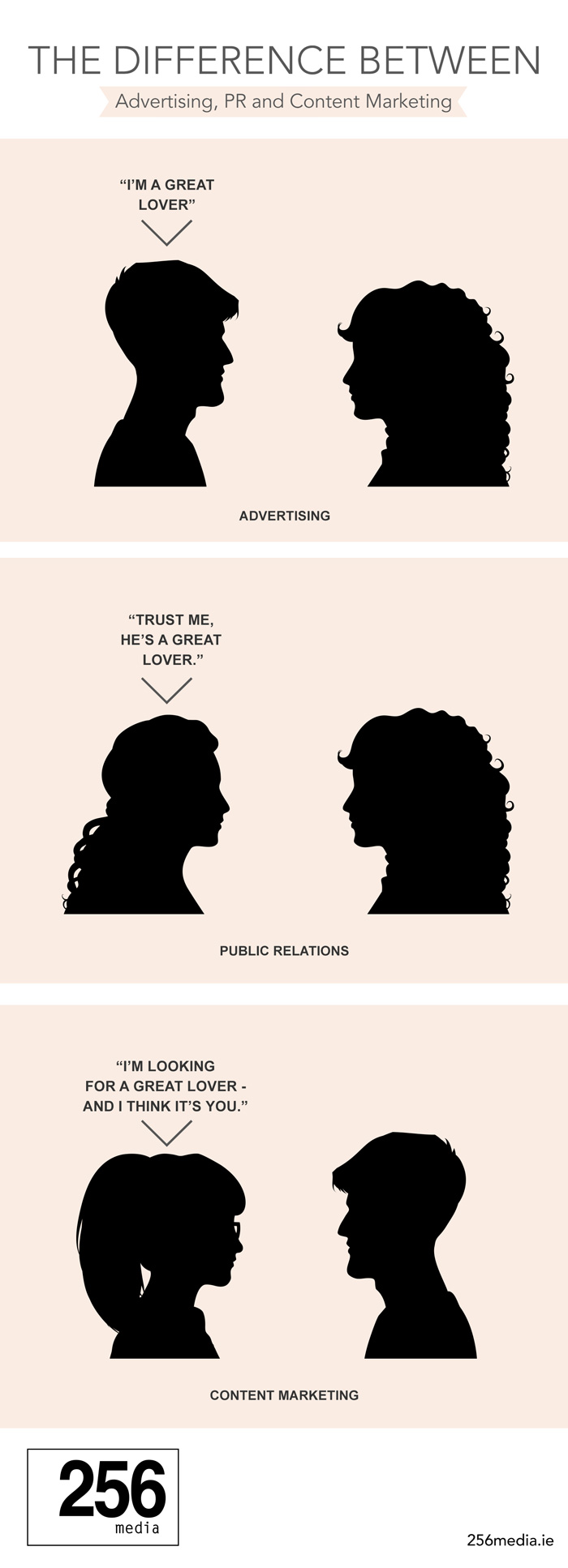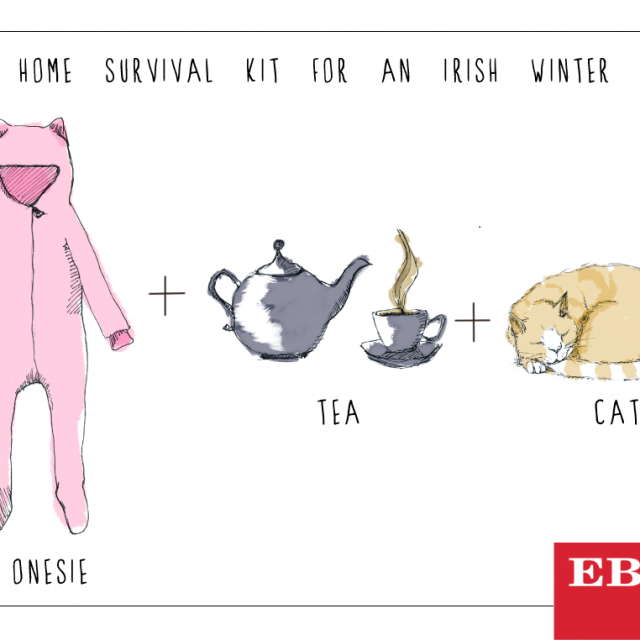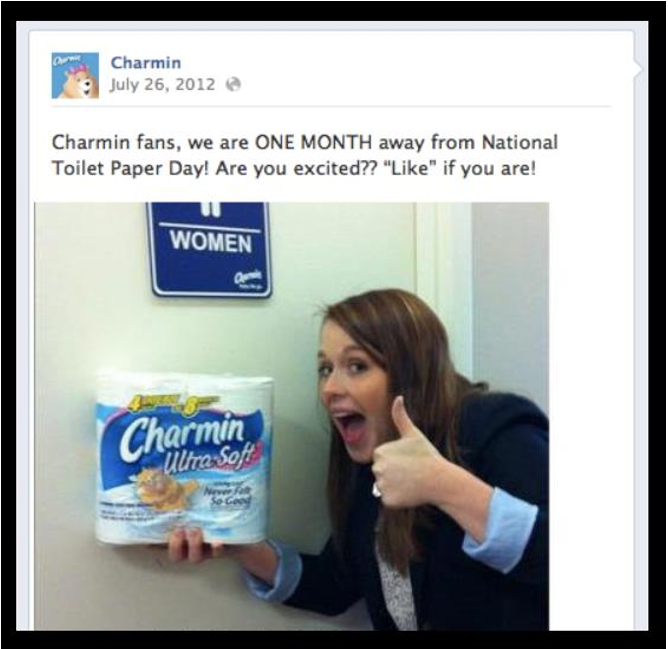Why treating content like advertising is damaging your ROI

Posted by Lisa Sills
June 8th, 2016
Content marketing isn't a project, it's a process. It's not a fling or a quick fumble. It's dedication. It's long-term. It's a marriage to marketing, in a metaphorical sense.
Advertising, on the other hand, is all about quick wins - about slamming your message into as many people's faces as possible.
A cool idea and a slick execution is all you need to blow up, but what about the lesser-loved? The small fish? The brands whose pennies need to stretch so much further? They can't afford to treat content marketing like advertising. Here's why.
Why content marketing isn't advertising
If you ask a marketer how many times someone needs to see your ad before they make a move, the answer varies. Some will tell you it’s three times. Some will say it’s seven.
A whole other line of thinking says it’s twenty. Me personally, I like the idea of three.
But here’s the thing. For content marketing, it doesn’t matter if it’s three or seven or thirty-seven. Why?
Because content marketing isn’t a campaign.
It’s not advertising. The tactics and goals are different. Content, often, is a softer sell that shuttles leads from point a to point b.
It’s not about creating a singular blog post that blows up. It's not about releasing a video or pulling off a stunt that grabs the headlines. The timeline is different.
So what is the goal or the point? It’s about long-term engagement. It’s a relationship and not the aforementioned fumble. Above all else, it’s about educating people and giving them the information they want when they want it.
The differences between content marketing and advertising
1. Saying vs. showing
Advertising is about taglines, claims, and instant gratification. This company is better than that company. KFC is Finger Lickin' Good. Subway helps you Eat Fresh. Mac is better than PC, just because. The customer journey is changing, and advertising (digital or otherwise) is more about brand awareness.
Content, on the other hand, is about information, creating relationships, and engagement. Online publishers with big followings have those followings because they get it: they create content that their audience wants to read and will find useful. That could be anything from a guide about how to stack your dishwasher properly to a webinar about why influencer marketing works.
As per our slightly cheeky graphic, the approach is different. Advertising tells. Content marketing offers and shows.
2. Fumble vs. long-term
An advertisement that works out in the wild often won't translate to a blog or social media. Social and content marketing are intertwined and while clever content and funny advertising works, the crux is in customer service and addressing concerns.
Brands in Ireland that do customer care on social well include EBS, AIB, Three, and Electric Ireland. They're responsive and informative and answer with responses that are personalised and not entirely rote. It goes further than this too, as you can pre-emptively use content to tailor to buyer journeys.
Let's say you're working in an estate agent. While June and July might be quiet months, that doesn't mean you down tools and don't post. Instead, you can create checklists for people who might be preparing to sell in a couple of months when the market picks back up. Aim to reach customers before, during, and after the purchase.
It's a hard-won relationship, absolutely, but if you can get a customer to hang around and listen to you, the potential is so much more than if they hear about you from a cursory glance at a billboard or on an ad on telly.
3. Impersonal vs. personalised
In the last couple of years, advertising on radio and TV has become more viral, more internet-heavy. The ads that work on TV doubly need to work on the internet too, with great ads going on to notch up millions of views on Facebook video or YouTube.
It's not about shoving good looking people and cute animals into ads anymore. We've been there and done that. Pedigree are a recent example who made the change with their parody ad for 'Doggie Dentures'. I was visiting my family home and was having dinner with my family when the ad came on. I hadn't seen it before.
I specifically remember looking at my mother and her noting how doggie dentures couldn't be real. And they weren't - but it was that element of surprise that caught us at our kitchen table. It's the kind of ad that'd be more at home on the internet, and that's why it works so well.
https://www.youtube.com/watch?v=RSOF1pVdb0w
The point is that we're moving away from lowest common denominator advertising. It's not enough anymore to be generic. Because of content marketing, we're used to ads that are tailored to us now.
It's why social media works so well. Bloomsbury targeted me with ads about the illustrated edition of the Philosopher's Stone. I bought it. They're now targeting me with ads about the illustrated version of the Chamber of Secrets. It's not a wild leap to presume I'll buy that too. Demographic and interest targeting allows for serving content in a uniquely targeted manner - and that's just the beginning, before we consider the long-game of inbound too.
In a nutshell, advertising puts content in front of you. Content marketing, on the other hand, sees people come to you. That's powerful.
And it's only going to get more so as we continue to move away from one-off advertising campaigns to long-term content marketing.
5 tips for creating personalised content that works
1. Start small
If you want to go big with personalisation you'll need to go big with technology. You'll need a CRM like HubSpot or Marketo for setting, monitoring, and controlling your workflows, and you'll need a budget to create the very many assets you'll need. However, you don't need to jump right in with the intention of personalising content for hundreds of customers.
If content generation en-masse and workflows are out of your budget right now, you can start on Facebook with small-scale personalisation to deliver leads. Take, for example, a piece of content from our clients, financial institution EBS. They ran the content some months ago in the dead of winter:
The post racked up over 700 likes because it was relevant and felt personalised.
Personalisation doesn't have to be a big effort. You don't even need to plaster names and jobs or whatever psychographical info everywhere. It can be even simpler, as in this quick example where another of our clients, Lisney, sourced and ran content that was uber-specific to their audience, all while clocking up brand awareness on their USP of local knowledge.
Compare these two posts to something like this, which is completely ludicrous:
No one loves toilet paper this much.
No one.
2. Understand your audience
Easier said than done - but the key to success. Before you launch into your content strategy, make sure you understand your audience. Know who they are beyond their demographics. Saying they are a 40 year old professional is one thing, but what do they like? Where do they hang out? How will your content be genuinely useful and actionable to them?
Answer those questions and you're off to a flying start.
3. Be a human
People do business with other people, not robotic jargon.
https://twitter.com/jambomeanshello/status/671137815846125568
What does this mean? We doubt even Fujitsu knew.
4. Don't be a creep about it
Through content, inbound, and social you can rake in heaps of information about your audience. And we mean heaps, especially if you tie your efforts in with a survey, for example. On Facebook, you can target people who recently moved and the location they're living in.
You could narrow it down even more and include their age or profession.
But imagine how creepy it'd be to get an ad for you: nameless person, who is a teacher, and who got married in the last six months. Showing your audience you know *that* much about them can be creepy. Remember, content marketing is about building a relationship. Over-personalise, and you'll send them running for the hills.
5. Create content that delivers value
And we're right back around to how content is a process and not a project. Create a one-off piece of great content and you might snare your audience once. They might pop in, read/consume whatever, and pop right out again.
You need to give them incentive to come back. Maybe that's an asset like a checklist or an ebook, or a newsletter that promises advice, tips, and competitions. Maybe it's even simpler and it's an active and engaging social channel. Your end goal with content is to turn a visitor into a lead, to take someone who might stop in for five minutes and nudge them towards a relationship with you.
And that's the crux of it, really.
Want to create a long-lasting content strategy to turn traffic into leads?
Why not get in touch and talk to our award-winning team. We’re creative content specialists with digital in our DNA so we’ll be happy to help.
In the meantime, follow us on Facebook, Twitter, and Instagram to keep up to date with all the latest news on content marketing and all things digital.

Lisa Sills

Previous Post
Is Google's personal assistant the future of search?
Next Post

The real purpose of email in the modern digital world
Subscribe Here
You may also like...
Nadia Reckmann | Aug 16, 2024
Nadia Reckmann | May 30, 2024
Nadia Reckmann | Nov 23, 2023










